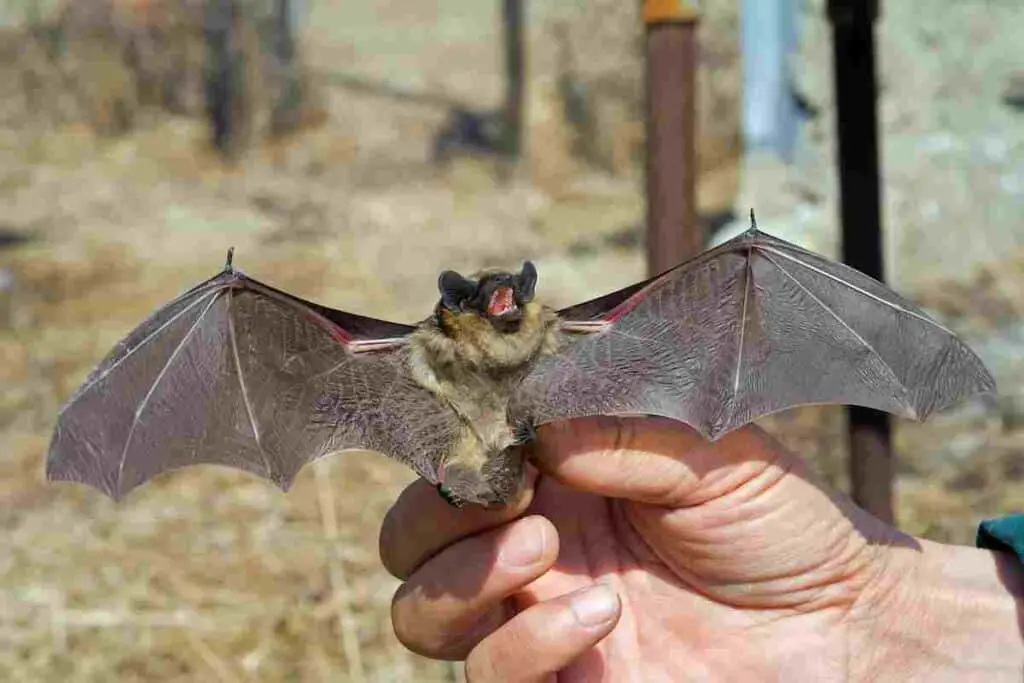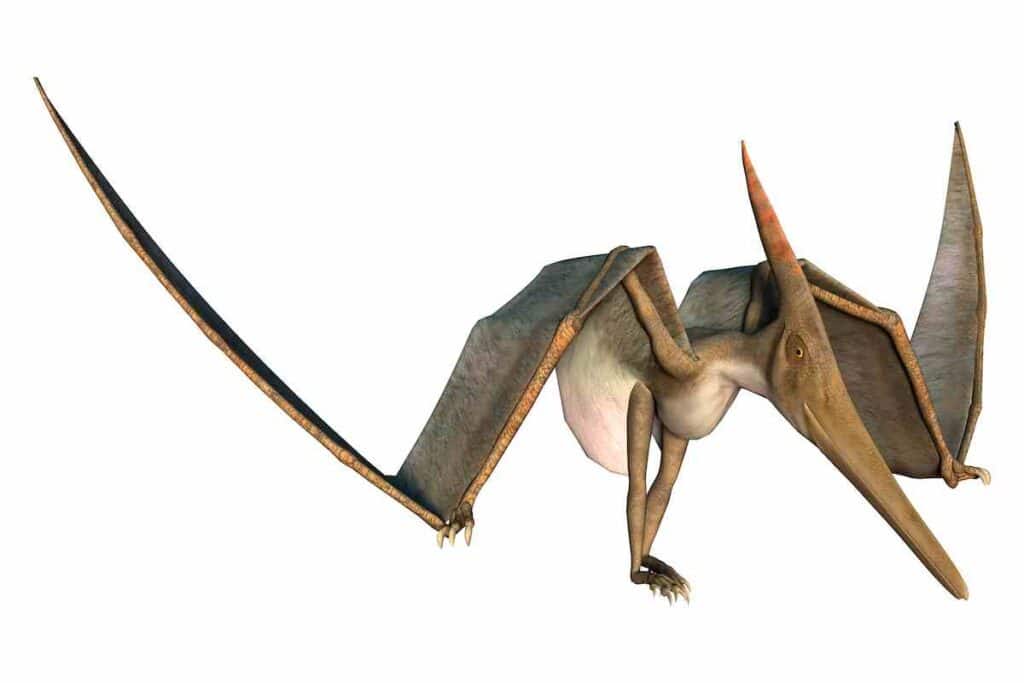I live in the countryside and one morning when going out to the woodshed, the family and I noticed a strange-looking creature standing on top of a box in the shed. As we got closer, it was clear that this small creature was a bat. It was dark brown, almost black, and as we approached, it tried to walk away. What was funny about this was that from all the research I have done on flying reptiles (videos, books, web articles, and news articles), I couldn’t help but notice that it was walking with the help of its wings. Then as it got to the edge of the box, it took off. That looked just like a pterosaur description of how it walked and took off flying! It makes me wonder, are bats similar to pterosaurs?
Bats and pterosaurs share traits such as both having wings, eating insects, and having teeth specially adapted for tearing flesh rather than grinding and chewing. However, there are some hard differences. Bats are mammals, and pterosaurs are ancient flying reptiles. Bats used echolocation to help them locate food and fly, while pterosaurs didn’t have this at all. Additionally, bats are mostly covered in hair, and pterosaurs had scale-like skin.
Bats are the only mammals capable of true flight. They belong to the classification Chiroptera, and there are two main groups of bats, the microbats and megabats. In general, megabats have longer snouts, larger eye sockets, and smaller ears, giving them a more dog-like appearance, which is the source of their nickname of “flying foxes.”
Bats can be found nearly everywhere, except in polar regions, extreme deserts, and a few isolated islands. They are considered important because the insect-eating microbats consume millions of bugs a night, acting as natural pest control plants.
Pterosaurs lived during all three periods of the Mesozoic era, going extinct during the K-T mass extinction event.

Neither birds nor dinosaurs pterosaurs were flying reptiles that flourished for more than 150 million years. Today’s leading theory is that pterosaurs, dinosaurs, and crocodiles are closely related and belong to a group known as archosaurs. As part of the anatomy of a pterosaur, it is especially important to observe its wings, which were made from bones and membranes of skin (and, depending on the species, other tissues).
Early pterosaurs often had heterodont teeth (more than one kind or morphology of teeth), varying in build, and some still had teeth in the palate. Some species had head crests.
In terms of size, many species were considerably large, with wide wingspans that characterized their suggested gliding ability.
Let’s take a look and see how bats and pterosaurs were similar and different.
Why Are Bats Similar to Pterosaurs?
Folks often relate bats to ancient pterosaurs. However, the temptation to liken them diminishes as you compare their physiological adaptations. Stephanie Hamelinck is from the Guelph Collegiate Institute in Guelph, Ontario, Canada.
Like many scientists, she believes that one thing becomes obvious when comparing a bat and a pterosaur.
Both bats and pterosaurs have wings for flight, though, but the two species are different in all other ways.
Pterosaurs are ancient, extinct reptiles, while bats are modern mammals. The reptile had scales, while the mammal still has fur covering its skin. One was cold-blooded and could only survive in warm weather, unlike its hot-blooded flying counterpart, which lives anywhere from the poles to deserts to rain forests.
Yet, these animals have some striking similarities that lead scientists to believe they are related. Are bats and pterosaurs related? Are these similarities enough to conclude that the two species are closely related, or is there a different explanation for their similarities?
The more unusual trait shared by bats and pterosaurs is that both seem to have appeared out of nowhere. Scientists call the phenomenon ‘population explosions.’ They suddenly appeared in the fossil record with no links leading up to them.
Having only slight differences from other flying creatures, it seems as though they were thrown into existence fully formed instead of growing gradually over time from a previous creature. (Source)
How can creatures similar in body plan, ecological niche, and genetic makeup appear completely different unless an outside influence?
Similarities:
Both have forelimbs modified for a flight consisting of a wing membrane stretched between the fingers. Both have a shoulder girdle made of bone, and both use their hind limbs for leaping (flight is not possible in pterosaurs).
The forelimbs are used for steering while gliding. However, bats can fold up their wings which not all pterosaurs could do. Bats are also more adept at maneuvering around trees than most pterosaurs were capable of doing. (Source)
Bats Are Mammals Just Like Humans
Bat anatomy is very similar to that of a human. Some people even mistake a bat for a rat or mouse. (Do you know what kind of mammal your pet is?)
Bats have hair, while reptiles have scales. They are warm-blooded, which means they can regulate their body temperature. They don’t have to depend on the environment as cold-blooded animals do.
While most mammals are covered by thick fur, some are nakedly covered by a thin hair.
Humans, elephants, and dolphins are some of the animals scientists consider to be naked mammals. (Source)
What Are the Differences – Bats vs. Pterosaurs?
Bats and pterosaurs had wings formed by muscular membranes stretching in between their fingers and toes. In bats, the membrane is very thin because of their ability to fly.
Pterosaurs did have a similar ability, but they were not able to fly as well as bats. Bats rely on echolocation to find their way in the dark, and pterosaurs lacked this skill. However, some pterosaurs screeched loud enough to cause damage to the ears of their competitors.
Pterosaurs have a head that is almost twice as long as its torso, but bats’ heads make up about 1/2 of their bodies. Most pterosaur fossils are found inland near rivers or lakes, while bats are found everywhere, especially where carnivores live because they eat insects like mosquitoes to stay alive.
Pterosaurs usually had short tails. Sometimes, they did not have one at all. Most bats also have no tails, but some are born with an extra-long one, which is shed when the animal reaches maturity.
Bats range from the size of a tiny mouse to that of a large bird. Pterosaurs can be anywhere from small, shrew-like animals up to nearly 30 feet long!
These differences help prove just how unique each creature is. Both belong to the suborder Archosauria, but they are different enough to earn their own classification (Pterosauria).
Although bats use a form of sonar called echolocation to find food in darkness, many pterosaurs lack this ability.
These animals are also specially recognized for their thin triangular heads rather than their wings or legs, as most predators focus more on these parts when hunting prey.
Bats also often come out at night because they are nocturnal. In contrast, most pterosaurs were diurnal (active during the day).
The diet of each animal varies greatly from one another and is varied among species. However, some features are common among members. For example, both groups are known to consume insects, small vertebrates, and plants.
Bats are also known to consume fruit, nectar, and pollen from flowers when available. On the other hand, most pterosaurs ate fish, insects, and small animals like lizards.
Both groups of animals lack teeth or stomachs. Their guts do not allow them to swallow food whole, unlike other species that have developed these features.
They’re different from birds, crocodiles, and mammals.
Instead, they possess sharp claws on their fingers, along with a pointed snout. The snout helps them tear off pieces of food to be swallowed.

The article you are reading is one of the 11 Series Articles connected to the Flying Dinosaur Types – Ultimate Guide to Pterodactyls, Pterosaurs. Check out the Ultimate Guide (see description and link directly below) or other key Series Articles selected for you at the bottom of this article!
Flying Dinosaur Types – Ultimate Guide to Pterodactyls, Pterosaurs
Main Article – With Links to 11 Series Articles
❖ Read Now! Flying Dinosaur Types – Ultimate Guide to Pterodactyls, Pterosaurs
This is the main article in the series and it is packed with information all about the flying reptiles that ruled the skies during the Mesozoic Era. It covers the different types of pterosaurs, from the basal pterosaurs and later species as well. There are sections on pterodactyl anatomy, classification, and phylogeny. The master article also covers:
—Interesting facts you may not know about pterosaurs
—Tables comparing wingspan sizes of different pterosaur species
—Links to all the Series Articles (11 in total!) which give deeper information about the pterosaurs
Pterosaur Flight Compared to How Bats Fly
How Pterosaurs Flew
Pterosaur flight is quite different from the frontal, down-stroke-like mode of flying that has evolved in several other groups of vertebrates. Pterosaur flight is a combination of two basic modes of animal flight:
- Rapid flapping
- Soaring
Pterosaurs would take off by jumping or running until they were airborne and immediately launched into level or near-level (skimming) flights. They flapped their wings continuously to remain aloft.
If they wanted to go up, they tilted forward slightly. When the pterosaur wanted to go down, it tilted back slightly.
This flying technique has often been compared to how modern sailplanes work. Like pterosaurs, an airplane glides along with the wind for reaction mass.
Only occasionally does it need to move its wing and tail to adjust its flight path. (Source)
How Bats Fly
Bats, on the other hand, use a different method of flight. They don’t flap continuously but instead flap intermittently while gliding (i.e., when they are not moving fast enough to fly by simply flapping their wings).
They often switch over to gliding flight when they are going fast enough that the airflow over the wing is too much for them to keep flapping their wings.
The lift is provided solely by the airflow over the wing surface. Thus, the angle of attack of the wing is increased to produce an upward force closest to its body (the leading edge). The movement forces the animal’s body upwards, producing an aerial motion.
The different flight styles of bats and pterosaurs mean that the wings of pterosaurs were set at a very high angle of attack. It’s quite inefficient for producing an upward force. But since they did not flap their wings continuously, it wasn’t a big issue.
Modern-day birds also have a high angle of attack and can flutter extensively. However, they flap their wings continually). Bats, on the other hand, use an upstroke to gain height. In addition, to lift production, they need more efficient control surfaces for lateral maneuverability. (Source)
Conclusion
It has been discussed that bats and pterosaurs are similar in how they have wings that they use to fly. However, most of those similarities end there. Pterosaurs are ancient reptiles, while bats are mammals and have fur covering their skin instead of scales. Pterosaurs appeared in the fossil record with no links leading up to them, unlike other flying creatures.
Thinking again of the morning visit by the small brown bat in my woodshed, it’s interesting how something that looks similar to the ancient flying reptiles, such as pterosaurs, can be so different when researched in scientific terms. For some reason, it still doesn’t satisfy the similarity of how it walked and jumped off the box!

